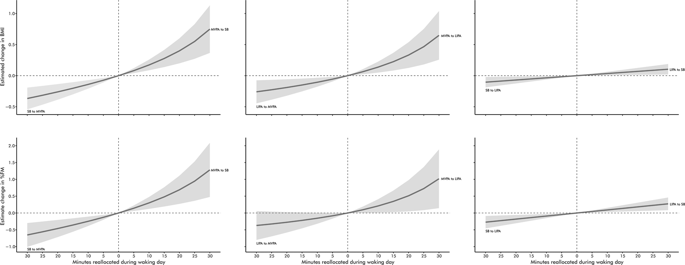International Journal of Obesity ( IF 4.2 ) Pub Date : 2020-01-07 , DOI: 10.1038/s41366-019-0514-x Jana Pelclová 1 , Nikola Štefelová 2 , Dorothea Dumuid 3 , Željko Pedišić 4 , Karel Hron 2 , Aleš Gába 1 , Timothy Olds 3 , Jana Pechová 1 , Izabela Zając-Gawlak 5 , Lenka Tlučáková 6

|
Background
This study aimed to use compositional data analysis to: (1) investigate the prospective associations between changes in daily movement behaviours and adiposity among elderly women; and (2) to examine how the reallocation of time between movement behaviours was associated with longitudinal changes in adiposity.
Subjects/methods
This is a 7-year longitudinal study in Central European older women (n = 158, baseline age 63.9 ± 4.4 years). At baseline and follow-up, light-intensity physical activity (LIPA), moderate-to-vigorous physical activity (MVPA) and sedentary behaviour were measured by accelerometer and body adiposity (body mass index [BMI], body fat percentage [%BF]) was assessed from measured height and weight and bioelectrical impedance analyser. Compositional regression with robust estimators and compositional longitudinal isotemporal substitution analysis explored if, and how, changes in movement behaviours were associated with adiposity.
Results
Over 7 years, the prevalence of obesity in the sample increased by 10.1% and 14.6% according to BMI and %BF, respectively, and time spent in sedentary behaviour increased by 14%, while time spent in LIPA and MVPA decreased by 14% and 21%, respectively. The increase in sedentary behaviour at the expense of LIPA and MVPA during the 7-year period was associated with higher BMI and %BF at follow-up (both p < 0.01). The increase in LIPA or MVPA at the expense of sedentary behaviour was associated with reduced BMI and %BF at follow-up. In our sample, the largest change in BMI (0.75 kg/m2; 95% confidence interval [CI]: 0.37–1.13) and %BF (1.28 U; 95% CI: 0.48–2.09) was associated with longitudinal reallocation of 30 min from MVPA to sedentary behaviour.
Conclusions
We found an association between longitudinal changes in daily movement behaviours and adiposity among elderly women in Central Europe. Our findings support public health programmes to increase or maintain time spent in higher-intensity physical activity among elderly women.
中文翻译:

运动行为之间时间的纵向重新分配是否与老年女性的肥胖有关?成分等时替代分析
背景
本研究旨在使用成分数据分析:(1)调查老年女性日常运动行为变化与肥胖之间的前瞻性关联;(2) 研究运动行为之间的时间重新分配如何与肥胖的纵向变化相关联。
科目/方法
这是一项针对中欧老年女性(n = 158,基线年龄 63.9 ± 4.4 岁)的 7 年纵向研究。在基线和随访时,通过加速度计和身体肥胖(体重指数 [BMI]、体脂百分比 [%BF ])通过测量的身高和体重以及生物电阻抗分析仪进行评估。使用稳健估计的成分回归和成分纵向等时替代分析探讨了运动行为的变化是否以及如何与肥胖相关联。
结果
7 年来,根据 BMI 和 %BF,样本中肥胖的患病率分别增加了 10.1% 和 14.6%,久坐行为的时间增加了 14%,而 LIPA 和 MVPA 的时间减少了 14% 和分别为 21%。在 7 年期间以 LIPA 和 MVPA 为代价的久坐行为增加与随访时更高的 BMI 和 %BF 相关(均p < 0.01)。以久坐行为为代价的 LIPA 或 MVPA 增加与随访时 BMI 和 %BF 降低有关。在我们的样本中,BMI(0.75 kg/m 2;95% 置信区间 [CI]:0.37–1.13)和 %BF(1.28 U;95% CI:0.48–2.09)的最大变化与 30 的纵向重新分配相关。最小从 MVPA 到久坐行为。
结论
我们发现中欧老年女性日常运动行为的纵向变化与肥胖之间存在关联。我们的研究结果支持公共卫生计划,以增加或维持老年女性在高强度体育活动中所花费的时间。











































 京公网安备 11010802027423号
京公网安备 11010802027423号